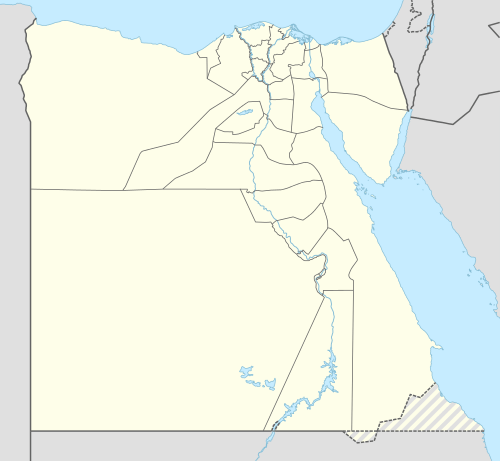KV21
| KV21 | |||
|---|---|---|---|
| Burial site of Unknown | |||
 KV21 | |||
| Coordinates | 25°44′22.5″N 32°36′10.8″E / 25.739583°N 32.603000°ECoordinates: 25°44′22.5″N 32°36′10.8″E / 25.739583°N 32.603000°E | ||
| Location | East Valley of the Kings | ||
| Discovered | 9 October 1817 | ||
| Excavated by | Giovanni Belzoni | ||
|
| |||
Tomb KV21 is located in the Valley of the Kings in Egypt. It contains the mummies of two women, thought to be Eighteenth Dynasty queens. In 2010, a team headed by Dr Zahi Hawass (the head of Egyptian Supreme council of antiquity at that time) and including geneticist Carsten Pusch among others used DNA evidence to identify one mummy as the biological mother of the two fetuses preserved in the tomb of King Tutankhamun.[1]
The tomb was discovered by Giovanni Belzoni in 1817. Belzoni described how easily the hair came out of one of the mummies when he tugged at it.
The tomb has a small low chamber next to the burial chamber where large white washed jars (probably containing embalming waste) were located.
James Burton, who mapped it in 1825, called it a "clean new tomb."
However, when the tomb was re-investigated in 1989 by Donald Ryan, the mummies had been torn to pieces, the jars stored next to the burial chamber were smashed, and a large graffito on one of the tombs walls proclaimed "ME 1826."
Announcing the DNA results in 2010, Carsten Pusch stated, "The data obtained from KV21A points to this mummy as the mother of the fetuses. Unfortunately we are not yet able to identify her as Ankhesenamun, Nefertiti's daughter."[2]

References
- ↑ Hawass, Zahi et al. Ancestry and Pathology in King Tutankhamun's Family. The Journal of the American Medical Association, February 17, 2010; 303(7):638-647.
- ↑ Lorenzi, Rosella. "King Tut Felled by Malaria, Bone Disease." Discovery News, February 16, 2010. Retrieved from http://news.discovery.com/archaeology/king-tut-dna-lineage.html.
- Belzoni, Giovanni Narrative of the operations and recent discoveries in Egypt and Nubia;...1820, John Murray, London.
- Reeves, N & Wilkinson, R.H. The Complete Valley of the Kings, 1996, Thames and Hudson, London.
- Siliotti, A. Guide to the Valley of the Kings and to the Theban Necropolises and Temples, 1996, A.A. Gaddis, Cairo.
External links
- Theban Mapping Project: KV21 - Includes description, images, and plans of the tomb.